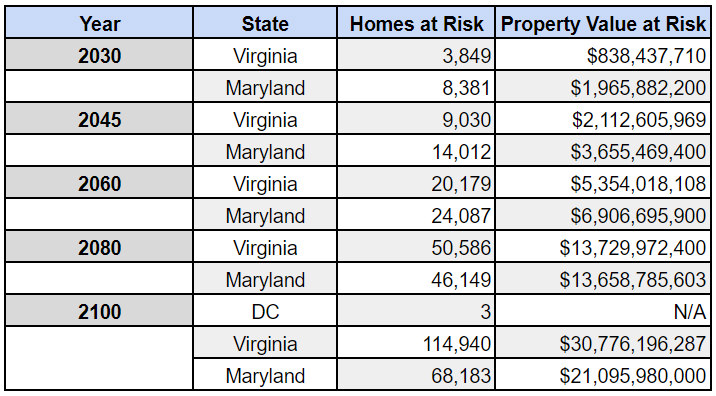What's Hot: Nicklas Backstrom's $12 Million McLean Home Finds A Buyer | HPO Recommends Approval Of Georgetown Conversion
 The Effect That Chronic Flooding May Have on the DC Area by 2100
The Effect That Chronic Flooding May Have on the DC Area by 2100
✉️ Want to forward this article? Click here.
Earlier this year, UrbanTurf reported on predictive software that illustrated where and to what extent flooding could impact the District in the year 2100, assuming that sea levels rise by 8 feet.
Now, the Union of Concerned Scientists (UCS) has released a report that estimates how many properties would be susceptible to "chronic" tidal flooding — and how much potential property value and revenue would be lost — over the years as sea levels continue to rise.
"Underwater: Rising Seas and the Implications for US Coastal Real Estate" shows that up to 311,000 homes along the coasts, with an aggregate market value of $120 billion, are at risk of chronic flooding within the next 30 years. By 2100, as many as 2.4 million homes with an aggregate value of $912 billion could be at risk. In this context, "chronic flooding" is defined as occurring at least 26 times per year on average, regardless of whether major storms are happening.
The states most at risk by century's end are unsurprisingly Florida, New Jersey and New York; Maryland, meanwhile, also has a lot of coastal communities that would experience great property loss. However, in the immediate DC area, Alexandria, Virginia is the closest jurisdiction that could see quantifiable levels of property loss.

The UCS report shows that in 2100, in a high-risk scenario, 283 homes in Alexandria (out of a current total of 41,616) will be susceptible to chronic flooding, leading to aggregate property value losses of $323 million. Meanwhile, only three homes in DC would experience chronic flooding (two in the 20024 zip code and one in the 20007 zip code); no figure was given for the estimated property value lost.
story continues below
loading...story continues above
For the entire state of Maryland in 2100, there could be 68,183 homes susceptible to chronic flooding at a loss of $21 billion; in Virginia, the tally would be 114,940 homes at a loss of $30.8 billion.

One needn't wait until 2100 to see these effects, however; if sea levels are rising apace with a high-risk scenario, 21 homes in Alexandria could be experiencing chronic flooding in 2030, causing property value losses of $14.5 million. In 2045, these numbers would rise to 40 homes and $32 million in lost value; in 2060, 70 homes and $55.3 million in lost value, and in 2080, 86 homes at risk with a value of $79.2 million.
"In contrast with previous housing market crashes, values of properties chronically inundated due to sea level rise are unlikely to recover and will only continue to go further underwater, literally and figuratively,” report co-author, economist and UCS policy director Rachel Cleetus stated.
The report, available in full here, uses a digital elevation model from the National Oceanic and Atmospheric Administration to determine the geographic areas that will experience chronic flooding; housing value estimates are gleaned from Zillow.
See other articles related to: climate change, flood, flooding, sea levels
This article originally published at https://dc.urbanturf.com/articles/blog/where-chronic-flooding-may-occur-in-the-dc-area/14129.
Most Popular... This Week • Last 30 Days • Ever

An application extending approval of Friendship Center, a 310-unit development along ... read »

With frigid weather hitting the region, these tips are important for homeowners to ke... read »

Today, UrbanTurf offers a brief explanation of what it means to lock in an interest r... read »

A new report from DC’s Office of Revenue Analysis highlights how millennials and wo... read »

The number of neighborhoods in DC where the median home price hit or exceeded $1 mill... read »
DC Real Estate Guides
Short guides to navigating the DC-area real estate market
We've collected all our helpful guides for buying, selling and renting in and around Washington, DC in one place. Start browsing below!
First-Timer Primers
Intro guides for first-time home buyers
Unique Spaces
Awesome and unusual real estate from across the DC Metro













